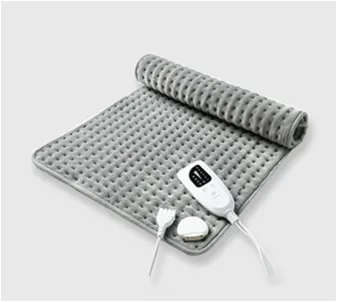
अगस्त . 15, 2024 14:54 Back to list
Understanding the Electricity Costs of Using Electric Heating Blankets for Warm Comfort
Understanding the Cost of Using an Electric Heating Blanket
As winter approaches, many households seek effective ways to keep warm without incurring high heating bills. Electric heating blankets have become a popular choice due to their ability to provide targeted warmth and comfort. However, potential users often wonder about the cost of operating such devices. In this article, we will explore the electricity costs associated with electric heating blankets, factors influencing these costs, and tips for efficient use.
What is an Electric Heating Blanket?
An electric heating blanket is a textile cover embedded with heating elements that can be adjusted to provide warmth to users. They typically come with different heat settings, allowing users to select the level of warmth that best suits their comfort needs. Commonly used on beds or couches, these blankets can alleviate the discomfort of colder temperatures, promote better sleep, and relieve tension in muscles.
Calculating the Cost of Electric Heating Blankets
To understand the operational cost of an electric heating blanket, it's essential to know how electricity consumption is measured. The amount of electricity a device uses is expressed in kilowatt-hours (kWh). To calculate the cost of using an electric heating blanket, follow these steps
1. Check the Power Rating Most electric blankets operate at a power rating of 60 to 100 watts. This information can usually be found on the product label or in the user manual.
2. Convert Watts to Kilowatts Since electricity is billed in kilowatts, convert the power rating to kilowatts by dividing by 1,000. For example, a 100-watt blanket would be 0.1 kilowatts.
3. Estimate Usage Hours Determine how many hours the blanket will be used. For instance, if a blanket is used for 8 hours a night, the total usage in a month would be 240 hours.
heating blanket electric cost

4. Calculate Monthly Consumption Multiply the kilowatt usage by the number of hours you plan to use the blanket. Using our example - 0.1 kW (power rating) x 240 hours = 24 kWh per month.
5. Apply Local Rates Check your electricity rate, typically charged per kWh. If your rate is $0.12 per kWh, the total monthly cost would be - 24 kWh x $0.12 = $2.88.
Factors Affecting Cost
Several factors can influence the overall cost of using an electric heating blanket
- Temperature Settings Higher heat settings increase electricity usage. Lowering the setting can extend the blanket's lifespan and reduce costs. - Insulation The quality of home insulation can significantly impact heating costs. Well-insulated areas retain warmth better, making electric blankets more effective. - Duration of Use Using the blanket strategically, such as warming the bed before sleep and turning it off after, can reduce costs.
Tips for Efficient Use
1. Preheat Your Bed Use the blanket to warm your bed before sleep and turn it off once you are comfortable to save energy. 2. Layer Up Consider wearing warm pajamas or layering blankets, which can allow you to use the heating blanket at lower settings. 3. Opt for Timed Settings Some electric blankets come with timers. Utilize these to prevent prolonged usage.
Conclusion
While electric heating blankets offer a cozy solution to keep warm during cold months, understanding their electricity costs can help users make informed decisions. With calculated usage and mindful practices, electric heating blankets can be an economical choice for effective heating, providing warmth without the shock of high electricity bills. By considering factors such as power settings, duration of use, and proper insulation, individuals can enjoy the benefits of electric blankets while keeping costs manageable.
-
Innovations and Applications of Modern Electric Heating Blankets
Jul.07,2025
-
Innovations and Applications of Electric Fleece Blanket Systems
Jul.07,2025
-
Functional and Cozy Solutions for Personalized Warmth
Jul.07,2025
-
Essential Comfort and Warmth Solutions: Heated Blanket Variants
Jul.07,2025
-
Enhancing Coziness with Warmth - Centric Blanket Solutions
Jul.07,2025
-
Enhancing Comfort and Warmth: Electric Blanket Solutions
Jul.07,2025
Realted Products



